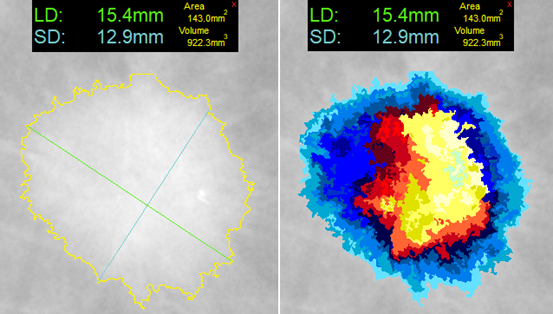DeepLook, Inc.’s Segmentation and Measurement Tool Captures FDA Clearance
One-click tool is designed to deliver precision consistently across all imaging modalities.
Connecticut-based software firm DeepLook, Inc., announced Thursday it has received U.S. Food & Drug Administration approval for DL Precise, its one-click segmentation and measurement tool.
This tool is designed to automate segmentation and measurement of suspicious findings across all imaging modalities, potentially improving workflow and reporting precision. Still, company officials noted, users can maintain full control and modify any automated measurement if they choose.
At left, one-click segmentation and measurement rendered by DL Precise. At right, DL Precise uses vivid color to illustrate segmentation.
Credit: DeepLook

DL Precise uses deterministic algorithms to contour object margins and measure long and short dimension axes, area, and estimated volume. With its single-click activation, it side-steps the complex, time-consuming manual set-up that frequently comes with current semi-automatic segmentation tools.
Not only does DL Precise work with any DICOM image and on all 510(k)-cleared viewers, but its patented technology can also be used universally with mammography, ultrasound, CT, and MRI, and the data captured can be fed directly into structured reports, making image comparisons across modalities easier. It can also be adapted to each viewer interface for easy PACS integration, according to company data.
DeepLook also has plans for future decision-support and diagnostic products based on radiomic data.
GE HealthCare Debuts AI-Powered Cardiac CT Device at ACC Conference
April 1st 2025Featuring enhanced low-dose image quality with motion-free images, the Revolution Vibe CT system reportedly facilitates improved diagnostic clarity for patients with conditions ranging from in-stent restenosis to atrial fibrillation.
Predicting Diabetes on CT Scans: What New Research Reveals with Pancreatic Imaging Biomarkers
March 25th 2025Attenuation-based biomarkers on computed tomography (CT) scans demonstrated a 93 percent interclass correlation coefficient (ICC) agreement across three pancreatic segmentation algorithms for predicting diabetes, according to a study involving over 9,700 patients.